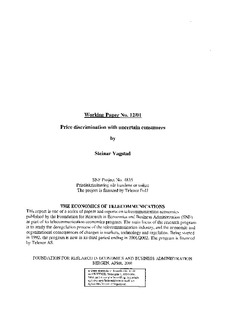| dc.contributor.author | Vagstad, Steinar | |
| dc.date.accessioned | 2006-09-27T07:59:20Z | |
| dc.date.available | 2006-09-27T07:59:20Z | |
| dc.date.issued | 2001-04 | |
| dc.identifier.issn | 0803-4028 | |
| dc.identifier.uri | http://hdl.handle.net/11250/166014 | |
| dc.description.abstract | Many goods and services are priced non-linearly, and a common way to implement nonlinear price schedules is to let consumers choose from a menu of two-part tariffs. If consumers know their demand at the time they choose tariff, there is often no principal difference between a fully nonlinear shedule and a (rich enough) menu of two-part tariffs. When consummers do not know their exact demand the two are not equivalent, and this paper analyzes the pros and cons of forcing the consumers to choose tariff before they learn their demand. | en |
| dc.format.extent | 2247688 bytes | |
| dc.format.mimetype | application/pdf | |
| dc.language.iso | eng | en |
| dc.publisher | SNF | en |
| dc.relation.ispartofseries | Working Paper | en |
| dc.relation.ispartofseries | 2001:12 | en |
| dc.title | Price discrimination with uncertain consumers | en |
| dc.type | Working paper | en |
